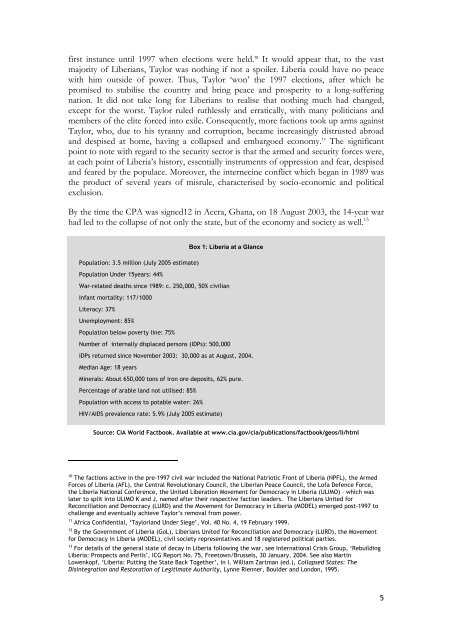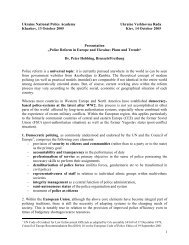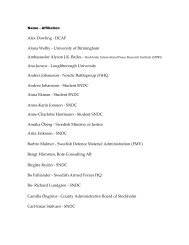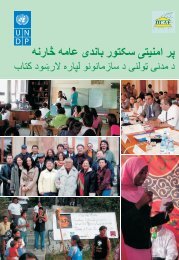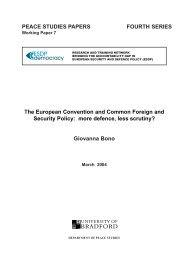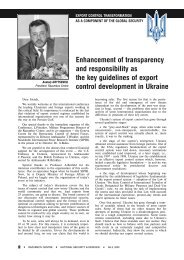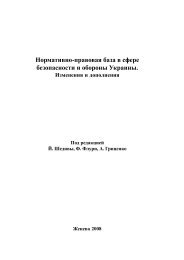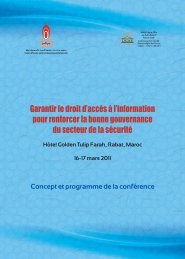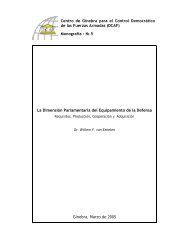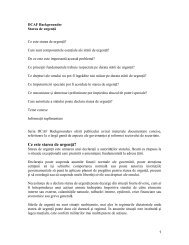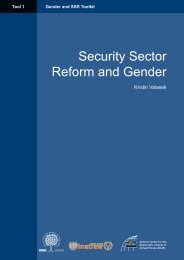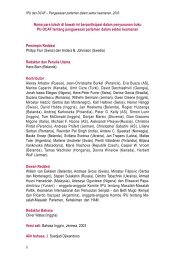The Challenges and Opportunities of Security Sector Reform in Post ...
The Challenges and Opportunities of Security Sector Reform in Post ...
The Challenges and Opportunities of Security Sector Reform in Post ...
You also want an ePaper? Increase the reach of your titles
YUMPU automatically turns print PDFs into web optimized ePapers that Google loves.
first <strong>in</strong>stance until 1997 when elections were held. 10 It would appear that, to the vast<br />
majority <strong>of</strong> Liberians, Taylor was noth<strong>in</strong>g if not a spoiler. Liberia could have no peace<br />
with him outside <strong>of</strong> power. Thus, Taylor ‘won’ the 1997 elections, after which he<br />
promised to stabilise the country <strong>and</strong> br<strong>in</strong>g peace <strong>and</strong> prosperity to a long-suffer<strong>in</strong>g<br />
nation. It did not take long for Liberians to realise that noth<strong>in</strong>g much had changed,<br />
except for the worst. Taylor ruled ruthlessly <strong>and</strong> erratically, with many politicians <strong>and</strong><br />
members <strong>of</strong> the elite forced <strong>in</strong>to exile. Consequently, more factions took up arms aga<strong>in</strong>st<br />
Taylor, who, due to his tyranny <strong>and</strong> corruption, became <strong>in</strong>creas<strong>in</strong>gly distrusted abroad<br />
<strong>and</strong> despised at home, hav<strong>in</strong>g a collapsed <strong>and</strong> embargoed economy. 11 <strong>The</strong> significant<br />
po<strong>in</strong>t to note with regard to the security sector is that the armed <strong>and</strong> security forces were,<br />
at each po<strong>in</strong>t <strong>of</strong> Liberia’s history, essentially <strong>in</strong>struments <strong>of</strong> oppression <strong>and</strong> fear, despised<br />
<strong>and</strong> feared by the populace. Moreover, the <strong>in</strong>ternec<strong>in</strong>e conflict which began <strong>in</strong> 1989 was<br />
the product <strong>of</strong> several years <strong>of</strong> misrule, characterised by socio-economic <strong>and</strong> political<br />
exclusion.<br />
By the time the CPA was signed12 <strong>in</strong> Accra, Ghana, on 18 August 2003, the 14-year war<br />
had led to the collapse <strong>of</strong> not only the state, but <strong>of</strong> the economy <strong>and</strong> society as well. 13<br />
Population: 3.5 million (July 2005 estimate)<br />
Population Under 15years: 44%<br />
Box 1: Liberia at a Glance<br />
War-related deaths s<strong>in</strong>ce 1989: c. 250,000, 50% civilian<br />
Infant mortality: 117/1000<br />
Literacy: 37%<br />
Unemployment: 85%<br />
Population below poverty l<strong>in</strong>e: 75%<br />
Number <strong>of</strong> <strong>in</strong>ternally displaced persons (IDPs): 500,000<br />
IDPs returned s<strong>in</strong>ce November 2003: 30,000 as at August, 2004.<br />
Median Age: 18 years<br />
M<strong>in</strong>erals: About 650,000 tons <strong>of</strong> iron ore deposits, 62% pure.<br />
Percentage <strong>of</strong> arable l<strong>and</strong> not utilised: 85%<br />
Population with access to potable water: 26%<br />
HIV/AIDS prevalence rate: 5.9% (July 2005 estimate)<br />
Source: CIA World Factbook. Available at www.cia.gov/cia/publications/factbook/geos/li/html<br />
10<br />
<strong>The</strong> factions active <strong>in</strong> the pre-1997 civil war <strong>in</strong>cluded the National Patriotic Front <strong>of</strong> Liberia (NPFL), the Armed<br />
Forces <strong>of</strong> Liberia (AFL), the Central Revolutionary Council, the Liberian Peace Council, the L<strong>of</strong>a Defence Force,<br />
the Liberia National Conference, the United Liberation Movement for Democracy <strong>in</strong> Liberia (ULIMO) – which was<br />
later to split <strong>in</strong>to ULIMO K <strong>and</strong> J, named after their respective faction leaders. <strong>The</strong> Liberians United for<br />
Reconciliation <strong>and</strong> Democracy (LURD) <strong>and</strong> the Movement for Democracy <strong>in</strong> Liberia (MODEL) emerged post-1997 to<br />
challenge <strong>and</strong> eventually achieve Taylor’s removal from power.<br />
11<br />
Africa Confidential, ‘Taylorl<strong>and</strong> Under Siege’, Vol. 40 No. 4, 19 February 1999.<br />
12<br />
By the Government <strong>of</strong> Liberia (GoL), Liberians United for Reconciliation <strong>and</strong> Democracy (LURD), the Movement<br />
for Democracy <strong>in</strong> Liberia (MODEL), civil society representatives <strong>and</strong> 18 registered political parties.<br />
13<br />
For details <strong>of</strong> the general state <strong>of</strong> decay <strong>in</strong> Liberia follow<strong>in</strong>g the war, see International Crisis Group, ‘Rebuild<strong>in</strong>g<br />
Liberia: Prospects <strong>and</strong> Perils’, ICG Report No. 75, Freetown/Brussels, 30 January, 2004. See also Mart<strong>in</strong><br />
Lowenkopf, ‘Liberia: Putt<strong>in</strong>g the State Back Together’, <strong>in</strong> I. William Zartman (ed.), Collapsed States: <strong>The</strong><br />
Dis<strong>in</strong>tegration <strong>and</strong> Restoration <strong>of</strong> Legitimate Authority, Lynne Rienner, Boulder <strong>and</strong> London, 1995.<br />
5


